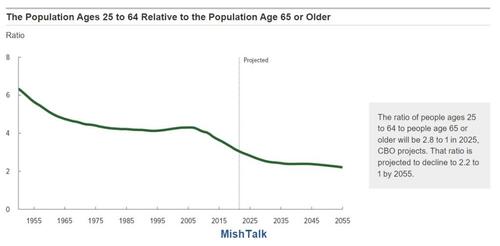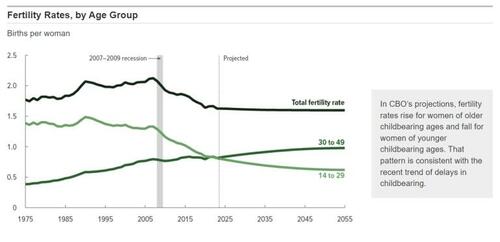
The CBO Lowers Expected Immigration, Birth Rate, And Population Growth
Authored by Mike Shedlock via MishTalk.com,
Deaths are expected to exceed births within a decade…

Deaths to Exceed Births
A Congressional Budget Office Report Lowers Population Growth.
-
In CBO’s projections, the population increases from 350 million people in 2025 to 372 million people in 2055, growing at an average rate of 0.2 percent per year. That rate is less than one-quarter of the average growth rate seen from 1975 to 2024 (0.9 percent per year).
-
The annual number of births is projected to exceed the annual number of deaths through 2032. Those net births account for about one-sixth of projected population growth during that period; net immigration accounts for the rest.
-
Beginning in 2033, annual deaths exceed annual births in CBO’s projections, and net immigration is projected to more than account for the population growth from 2033 to 2055.
Social Security Implications

In CBO’s projections, the number of people age 65 or older grows more quickly than the number of people ages 25 to 54. That difference affects the number of people who are employed, because people age 65 or older are less likely to work and are generally eligible for Social Security and Medicare. In addition, the number of people age 24 or younger declines in CBO’s projections.
Fertility Rates by Age Group

Fertility Below Replacement Rate
-
In CBO’s projections, fertility rates continue to be lower than the replacement rate—the fertility rate required for a generation to exactly replace itself in the absence of immigration—which is 2.1 births per woman. Mortality rates generally continue to decline, and immigration becomes an increasingly important source of overall population growth.
-
CBO projects fertility rates on the basis of its assessment of past trends. For the 20 years before the 2007–2009 recession, the total fertility rate averaged 2.02 births per woman. After peaking at 2.12 in 2007, that rate has generally fallen, largely because of lower fertility rates among women ages 15 to 24. The total fertility rate was 1.64 births per woman in 2020 and declined slightly, to 1.62, in 2023 (the most recent year for which data were available when these projections were made). In CBO’s projections, the total fertility rate equals 1.62 births per woman in 2025, 1.60 in 2035, and 1.60 in 2055.
-
The fertility rate for women under 30 is projected to keep falling: from 0.79 births per woman in 2025 to 0.62 by 2055. The rate for women age 30 or older is projected to increase, from 0.84 births per woman in 2025 to 0.98 by 2055, in part because CBO expects women to delay bearing children until older ages.
-
CBO’s projections of fertility rates are subject to considerable uncertainty. If future trends in fertility differed from what CBO projects, the agency’s projections of overall fertility rates and the age distribution of mothers would change as well.
Net Immigration

Net Immigration Crash
-
In CBO’s projections, net immigration totals 2.0 million people in 2025, 1.5 million in 2026, and an average of 1.1 million per year from 2027 to 2055.
-
For 2025 to 2045, CBO based its estimates of net immigration on its assessment of recent trends. After 2045, net immigration in a given year is projected to grow at roughly the same rate at which the overall population grew in the previous year, which is projected to average 0.04 percent annually.
-
CBO develops its projections of net immigration so they fall in the middle of the likely range of outcomes in the absence of new legislation or significant administrative or judicial changes.
Four Mish Observations
-
There are many other interesting charts in the report. None of this is a surprise.
-
Having kids is very expensive so fewer people have them.
-
Immigration has kept the US growing but Trump will dramatically slow that process.
-
If Trump succeeds in deporting 15 million, the US would have an instant labor shortage. But he won’t come close.
Related Posts
January 2, 2025: Five Funding and Legal Obstacles to Trump’s Immigration Plans
The way to a deal involves giving legal status for dreamers and mixed families in return for more funding for a wall, more judges, and ICE agents.
Throw in some additional funds for cooperation for cooperation from cities and states and you will have a solid deal.
What’s a Good Deal?
I discussed the essentials of a good deal in The New Home for Hispanics is the Republican Party
Florida Congresswoman Maria Salazar, a Republican, has some great ideas.
Her “Dignity Act” would allocate $35 billion in funding to enhance and improve infrastructure and technology between and at ports of entry. It also reforms the U.S. asylum system to make a final determination of asylum eligibility for most asylum seekers at the border within 60 days.
Tyler Durden
Thu, 01/16/2025 – 13:25
